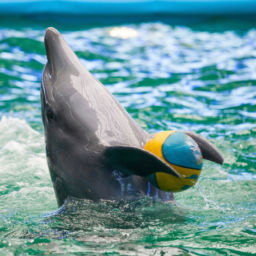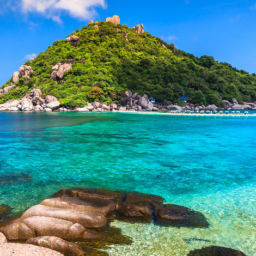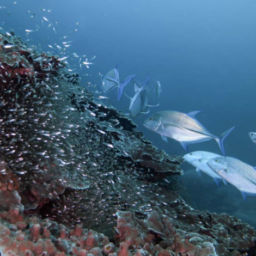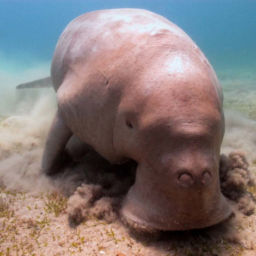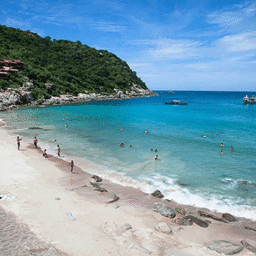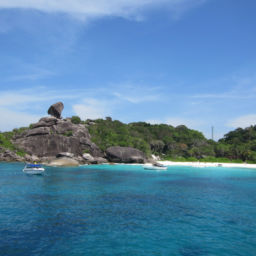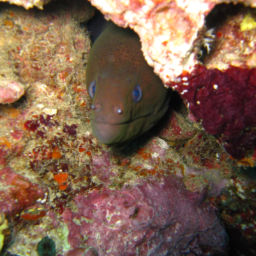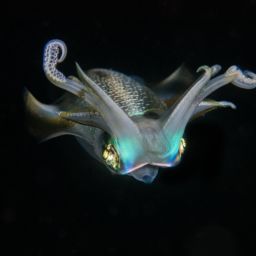On the southwestern coast of mainland Thailand is the picturesque town of Krabi. With beaches, caves, waterfalls, temples, mountains, and hot springs, Krabi has become popular with tourists looking for adventure. Kayaking, rock climbing, hiking, and whitewater rafting are just some of the activities on offer. But the real highlight is the scuba diving in Krabi
Krabi is a great place to base yourself if you want to dive the Phi Phi islands and sites around Koh Lanta and Phuket. But don’t overlook the top-class dive sites that are right on its doorstep. Off the coast of Krabi’s Ao Nang Beach is a group of islands that offers something for everyone. Drop-offs, reefs, wall dives, swim-throughs, and caverns are home to over 200 species of fish and 80 species of coral.
Average depths here are around 66 feet (20 m) so are ideal for beginners. If you’re looking for an underwater adventure, look no further than Krabi. Here are some of the most popular local dives in the region.
Koh Talu
Koh Talu literally means “island you can go through,” and gets its name from two shallow swim-throughs that run right beneath the island. The main tunnel cuts through the entire length of the island and its width means that it’s accessible to most divers.
Large barracuda often hang out at the tunnel entrance. The reef is made up of soft tree, mushroom, and table corals and surrounding the island are numerous pinnacles so there’s plenty to explore. Seahorses, bent-stick pipefish, pufferfish, razorfish, flabellina nudibranches, and sea kraits are just some of the many highlights at Koh Talu.
Koh Ha
Koh Ha is home to over 60 varieties of coral and many gorgonian sea fans. The eastern side is mainly patch staghorn and to the southeast is a wall dropping down to 60 feet (18 m) covered in sea whips and fans. These provide shelter to an amazing array of shrimp, crabs and bamboo sharks that hide beneath rocks. Look in the sand for cuttlefish and stingrays. If you’re diving Koh Ha in the early morning, watch for leopard sharks that tend to laze on the sand.
Koh Yawabon
Koh Yawabon boasts the longest swim-through in the region at 164 feet (50 m). Part way through you can actually surface inside a chamber and pause to appreciate the huge stalactites hanging from the ceiling. The tunnel is only 33 feet deep (10 m) but strong currents and a large no-light zone make it suitable for experienced divers only.
Because of this, many dive shops bypass the site, which makes it popular with large schools of usually shy fish. Koh Yawabon is also a macro photographer’s dream, with divers regularly spotting tiger tail seahorses and as many as 20 different species of nudibranch in a single dive.
Koh Dor
The closest dive site to Krabi is Koh Dor. A good mixture of stony porites, soft coral, sea fans, leather coral, and sea whips cover the reef, and barrel sponges dot the area. You’ll see porcupinefish, dog-faced pufferfish, and trumpetfish, along with sea cucumbers and black spiny sea urchins that cover the sandy bottom.
The real draw at Koh Dor, however, is that it’s the best spot in Krabi to see blacktip reef sharks. These elusive creatures often appear in the afternoon on the western side of the island. Although you may catch a glimpse of one while diving, the best way to observe them is by snorkeling during your lunch break.
Koh Yawasam
Two neighboring rocky islets make up Koh Yawasam. Shallow patches of table and staghorn coral, areas of flat sand, and deeper waters combine to make this an ideal site for training dives. It’s also a popular spot for snorkeling trips from Krabi. The marine life is varied and you’ll see numerous nudibranchs, angelfish, butterflyfish, snapper, barracuda, moray eels, and bamboo sharks. Koh Yawasam is also the best place to see the rare red saddleback anemonefish.
HTMS Ravi
Koh Yawasam is the location of Krabi’s very own wreck. The 120-foot (36 m) long, 33-foot (10 m) wide tank-landing craft, HTMS Ravi, was purpose sunk in April 2013 to create an artificial reef. Today it sits upright at 82 feet (25 m) below the surface and is teeming with marine life for divers of all levels to explore.
Koh Si
Another popular spot with snorkelers and divers is Koh Si with its large coral-covered pinnacles on either side of the island. Visibility is variable but when conditions are right, you’re likely to see large schools of snapper, fusilier, sardines, and big-mouth mackerel. To the north of the island tubastrea corals, sea whips, and barrel sponges cover a steep wall. There’s also small cavern where spiny lobster and banded sea snakes hang out. Scorpionfish, seahorses, nudibranchs, bamboo sharks, filefish, and pipefish hide among the reef. Koh Si is also a good place to get a brief glimpse of blacktip reef sharks.
When to go
Having a tropical climate means Krabi is one of Thailand’s year-round destinations for scuba divers. Water temperatures vary only slightly between 82 and 87 F (28 and 30 degrees C). High season lasts from November to April when the northwest monsoon brings sunny days and light breezes. December and January are the busiest months and accommodation in Krabi during this time becomes expensive — if you can find anything available.
May to October is still pleasant, averaging 20 days of sunshine a month. But the southwest monsoons bring rain and winds, making conditions unpredictable. During this low season, dive shops often cancel trips due to rough seas.
February, March, and April are the months to visit Krabi if you want to avoid crowded dive sites. Accommodation is reasonably priced during this time and you’ll have near-perfect weather and calm seas for your diving adventure.






